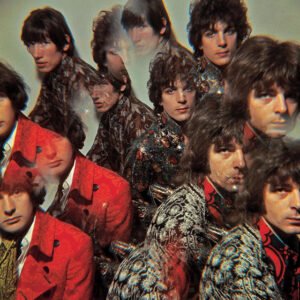Pink Floyd stands as one of the most influential and innovative bands in the history of rock music. Formed in London in 1965, the group quickly transcended the psychedelic sounds of their early years to become pioneers of progressive rock. Known for their complex compositions, philosophical lyrics, and groundbreaking use of studio technology, Pink Floyd crafted a legacy that resonates across generations. Their music, often described as a sonic exploration of the human condition, has sold over 250 million records worldwide, cementing their place among the all-time greats. From the haunting beauty of The Dark Side of the Moon to the theatrical grandeur of The Wall, Pink Floyd’s work continues to captivate audiences, challenging listeners to delve deeper into themes of alienation, conflict, and the search for meaning.
Early Years and Formation
Founding Members
Pink Floyd was originally formed by a group of young, aspiring musicians who met while studying in London. The band’s core began with Syd Barrett, a Cambridge-born guitarist and songwriter known for his eccentric creativity and deep interest in art. Barrett was joined by Roger Waters, also from Cambridge, who played bass guitar and shared a similar artistic inclination. Nick Mason, a London native with a passion for jazz and classical music, took on the role of drummer. Richard Wright, another Londoner, played keyboards and had a background in architecture and jazz. This quartet laid the foundation for what would become Pink Floyd, each member bringing a unique set of influences and skills that would shape the band’s early sound.
Formation
Pink Floyd’s formation was rooted in the vibrant and experimental cultural milieu of 1960s London. Initially known as The Tea Set, the band’s early years were heavily influenced by the burgeoning British psychedelic scene, which was itself a response to the broader countercultural movement sweeping through the West. The name “Pink Floyd” was coined by Barrett, who combined the first names of two American blues musicians, Pink Anderson and Floyd Council, reflecting the band’s deep respect for the blues tradition. In their early days, Pink Floyd became a regular fixture at the UFO Club, a hotbed for London’s psychedelic underground, where their experimental approach to music and performance quickly set them apart from their contemporaries.
Initial Sound and Style
Pink Floyd’s initial sound was a heady mix of blues, jazz, and experimental rock, heavily laced with the psychedelic sensibilities of the 1960s. Under Syd Barrett’s leadership, the band’s early music was characterized by its whimsical, surreal lyrics, and innovative use of feedback, echo, and other studio effects. Songs like “Arnold Layne” and “See Emily Play” showcased Barrett’s playful yet haunting songwriting style, while the instrumental piece “Interstellar Overdrive” highlighted the band’s penchant for extended improvisation and sonic exploration. Their debut album, The Piper at the Gates of Dawn (1967), exemplified this approach, blending Barrett’s visionary creativity with the band’s collective drive to push musical boundaries. This period marked the birth of Pink Floyd’s signature sound, an eclectic blend that would later evolve into the more structured, conceptual works that defined their legacy.
Rise to Fame

Breakthrough Albums
Pink Floyd’s journey to prominence began with the release of their debut album, The Piper at the Gates of Dawn in 1967. This record, a product of the band’s early psychedelic phase, was largely shaped by Syd Barrett’s visionary creativity. The album captured the zeitgeist of the 1960s with its whimsical, surreal lyrics, and innovative soundscapes. Tracks like “Astronomy Domine” and “Interstellar Overdrive” showcased the band’s ability to merge experimental rock with cosmic themes, setting them apart from the more straightforward pop acts of the time. The Piper at the Gates of Dawn became a critical success in the UK, solidifying Pink Floyd’s place in the burgeoning psychedelic rock scene.
Following Barrett’s departure due to mental health issues, the band released A Saucerful of Secrets (1968), marking the beginning of David Gilmour’s role as a guitarist and vocalist. While the album did not achieve the same commercial success as their debut, it laid the groundwork for their evolving sound, combining experimentalism with more structured compositions. The band’s third album, Ummagumma (1969), further showcased their experimental tendencies, with one disc of live performances and another featuring solo compositions by each member. Although this album received mixed reviews, it was an important stepping stone in the development of their later, more cohesive work.
However, it was with the release of Meddle in 1971 that Pink Floyd began to solidify their position as major players in the rock world. The album’s centerpiece, “Echoes,” was a 23-minute epic that encapsulated the band’s growing ambition and ability to create immersive, cinematic soundscapes. Meddle was a critical and commercial success, pointing towards the more conceptually unified albums that would soon define Pink Floyd’s legacy.
Key Singles
While Pink Floyd was primarily known for their albums, a few key singles played a significant role in establishing their early reputation. “Arnold Layne,” their debut single released in 1967, was a whimsical yet dark tale of a cross-dressing clothes thief. It reached the Top 20 in the UK and demonstrated Barrett’s knack for combining eccentric storytelling with catchy melodies. The follow-up single, “See Emily Play,” was even more successful, peaking at number six on the UK charts. This track, with its dreamlike lyrics and innovative production techniques, became one of the defining songs of the psychedelic era and helped Pink Floyd reach a broader audience.
Although Pink Floyd would later become known for their album-oriented approach, these early singles were crucial in building their initial fanbase and establishing the band as a unique and innovative force in the 1960s music scene.
Innovative Approach
Pink Floyd quickly distinguished themselves from their contemporaries through their pioneering use of experimental sounds, studio effects, and live performances. Their early work was marked by a willingness to push the boundaries of traditional rock music. They were among the first to use tape loops, backward recordings, and extensive reverb to create an otherworldly atmosphere in their music. Tracks like “Interstellar Overdrive” and “A Saucerful of Secrets” featured lengthy, improvisational passages that broke away from conventional song structures, immersing listeners in a sonic experience that was as much about mood and texture as it was about melody and rhythm.
In addition to their studio innovations, Pink Floyd’s live performances were groundbreaking. They were pioneers in the use of light shows, combining their music with elaborate visual effects that transformed their concerts into multi-sensory experiences. Their performances often featured elaborate projections, smoke machines, and even quadraphonic sound systems, creating an immersive environment that captivated audiences. This innovative approach not only set them apart from other bands of the era but also laid the foundation for the grand, theatrical live shows that would become a hallmark of their later career.
Peak of Success

Classic Albums
The 1970s marked the pinnacle of Pink Floyd’s success, a period during which they released a series of albums that would not only define their career but also alter the landscape of rock music forever. Their magnum opus, The Dark Side of the Moon (1973), is perhaps the most iconic. This album, a seamless blend of music, sound effects, and philosophical musings, spent a staggering 741 weeks on the Billboard charts and remains one of the best-selling albums of all time. Tracks like “Money,” “Time,” and “Us and Them” became instant classics, and the album’s pioneering use of studio technology set a new standard for album production. The Dark Side of the Moon was more than just a collection of songs; it was a cohesive, conceptual work that explored universal themes of human experience, such as mortality, greed, and mental illness.
Wish You Were Here
Following the massive success of The Dark Side of the Moon, Pink Floyd released Wish You Were Here in 1975, an album that was both a tribute to their troubled former bandmate Syd Barrett and a critique of the music industry. The centerpiece of the album, “Shine On You Crazy Diamond,” is a poignant reflection on Barrett’s genius and his descent into mental illness, while the title track, “Wish You Were Here,” resonates with themes of absence and loss. The album’s combination of personal reflection and biting commentary struck a chord with audiences, further solidifying Pink Floyd’s reputation as a band that could deliver both musically and emotionally.
The Wall
In 1979, Pink Floyd released The Wall, a rock opera that took their conceptual approach to new heights. Written primarily by Roger Waters, The Wall is a deeply personal narrative about isolation, alienation, and the construction of psychological barriers. The album’s story of “Pink,” a rock star who becomes increasingly detached from reality, is told through a series of powerful songs, including “Another Brick in the Wall, Part 2,” “Comfortably Numb,” and “Hey You.” The Wall’s grandiose scale was matched by its commercial success, becoming one of the best-selling albums of all time and spawning a visually striking live show that would become legendary. The album’s success was further cemented by the 1982 film adaptation, directed by Alan Parker, which brought its themes and imagery to an even wider audience.
Conceptual Themes
One of the hallmarks of Pink Floyd’s peak period was their ability to weave complex, conceptual themes into their music, creating albums that were not just collections of songs but cohesive artistic statements. The Dark Side of the Moon delved into the pressures and anxieties of modern life, with recurring motifs of time, madness, and the inevitability of death. The album’s exploration of mental illness, particularly in tracks like “Brain Damage” and “Eclipse,” was both a reflection of the band’s own experiences and a broader commentary on society’s struggles with these issues.
Wish You Were Here continued this exploration of alienation, focusing on the personal toll of fame and the dehumanizing effects of the music industry. The album’s title track and “Shine On You Crazy Diamond” served as elegies for Syd Barrett, while tracks like “Welcome to the Machine” and “Have a Cigar” criticized the industry’s commodification of art and artists.
The Wall took the theme of alienation to its most extreme expression, chronicling the protagonist’s descent into madness as he builds a metaphorical wall around himself. The album’s narrative structure allowed Pink Floyd to explore a wide range of themes, from the impact of war (as seen in “Goodbye Blue Sky”) to the oppressive nature of authority (highlighted in “Another Brick in the Wall, Part 2”). Mental illness, a recurring theme in the band’s work, reached its most harrowing portrayal in “Comfortably Numb,” a song that captures the numbness and disconnection that comes with psychological trauma.
Cultural Impact
The cultural impact of Pink Floyd’s classic albums extends far beyond the realm of music. The Dark Side of the Moon became a cultural phenomenon, its iconic prism cover becoming one of the most recognizable images in popular culture. The album’s themes of existential angst and societal critique resonated deeply with the post-1960s generation, influencing not only music but also literature, film, and art. It has been referenced, parodied, and celebrated in countless ways, cementing its place in the cultural lexicon.
Wish You Were Here and The Wall also left a lasting imprint on popular culture. Wish You Were Here’s critique of the music industry and its exploration of loss and longing struck a chord with artists across various mediums. The Wall, with its grand narrative and powerful imagery, transcended the boundaries of rock music to become a multimedia experience, influencing everything from stage design to filmmaking. The film adaptation of The Wall became a cult classic, its stark, surreal visuals capturing the album’s themes of despair and rebellion. The album’s impact is also evident in its influence on subsequent generations of musicians, who have drawn inspiration from its conceptual depth and emotional intensity.
Politically and socially, Pink Floyd’s music of this era also resonated with movements and ideologies that questioned authority and challenged the status quo. The Wall’s critique of authoritarianism and its exploration of the personal costs of political conflict made it particularly relevant in a world grappling with the tensions of the Cold War, and it continues to be a touchstone for discussions around these issues.
Internal Dynamics and Changes

Band Tensions
The story of Pink Floyd is as much about their groundbreaking music as it is about the complex and often turbulent relationships between its members. From the band’s inception, the interpersonal dynamics among Syd Barrett, Roger Waters, David Gilmour, Nick Mason, and Richard Wright played a crucial role in shaping their creative direction, for better and for worse.
Syd Barrett, the band’s original leader and primary songwriter, was a creative force with a unique vision. However, his increasing mental instability, exacerbated by heavy drug use, led to erratic behavior that strained his relationship with the other members. Barrett’s unpredictable nature made it difficult for the band to function, and this tension ultimately resulted in his departure in 1968. The decision to replace Barrett was emotionally challenging, particularly for Roger Waters and David Gilmour, who had been friends with Barrett since their youth in Cambridge. Despite the difficulty, the band knew that continuing with Barrett would be impossible, and his exit marked a significant shift in the band’s internal dynamics.
Syd Barrett’s Departure
After Barrett’s departure, Roger Waters began to assume a more dominant role in the band, both as a songwriter and as a conceptual leader. Waters’ assertiveness was initially welcomed, as his vision helped propel Pink Floyd to new heights. However, as the years progressed, this dominance led to growing tensions within the group, particularly with Richard Wright and David Gilmour. Waters’ increasingly autocratic approach to the band’s creative process often left little room for collaboration, causing resentment among the other members. Nick Mason, the band’s drummer, often found himself in the role of mediator, trying to keep the peace amid the growing discord.
Lineup Changes
The most significant lineup change in Pink Floyd’s history was the departure of Syd Barrett, whose decline into mental illness forced the band to confront a difficult reality. As Barrett’s behavior became more erratic, missing rehearsals and performances, the band had no choice but to ask David Gilmour, a friend and fellow guitarist, to join the group as a backup. Initially, the plan was for Gilmour to support Barrett during live performances, but it quickly became apparent that Barrett could no longer function as a member of the band. In early 1968, Pink Floyd made the painful decision to part ways with Barrett, with Gilmour officially taking his place as the band’s lead guitarist and vocalist.
The Introduction of Gilmour
This lineup change was pivotal in Pink Floyd’s evolution. Gilmour’s entry into the band brought a new level of musicianship and stability, allowing Pink Floyd to develop the sound that would define their most successful work. However, it also marked the beginning of Roger Waters’ ascendance as the band’s primary creative force. Over the years, Waters’ influence grew to the point where he became the de facto leader of Pink Floyd, driving the band’s thematic and musical direction, particularly on albums like The Dark Side of the Moon and The Wall.
As Waters’ influence increased, so too did the tensions within the band. Richard Wright, in particular, found himself at odds with Waters, who often sidelined Wright’s contributions. By the time the band was working on The Wall in 1979, the relationship between Waters and Wright had deteriorated to the point where Waters demanded Wright leave the band. Wright agreed to step down, though he continued to perform as a session musician for the band during their Wall tour. This marked the first time Pink Floyd had recorded an album without one of its original members, a sign of the deepening rift within the group.
Creative Differences
Creative differences were a recurring source of conflict within Pink Floyd, particularly as Roger Waters became more dominant in the band’s creative process. In the early years, the band’s collaborative spirit allowed them to explore new musical territories together. However, as Waters’ vision for the band became more defined, he began to assert more control over the songwriting and conceptual direction, often at the expense of input from the other members.
David Gilmour, who had been a key contributor to the band’s sound with his distinctive guitar work and vocal style, increasingly found himself at odds with Waters’ authoritarian approach. Gilmour felt that the collaborative nature of the band was being eroded, with Waters dictating the creative direction without considering the ideas of his bandmates. This tension came to a head during the recording of The Wall, where Waters wrote most of the material and insisted on complete control over the project. Gilmour’s frustration was evident, and while he still made significant contributions—most notably on tracks like “Comfortably Numb”—he felt increasingly marginalized.
Waters’ Growing Dominance
Richard Wright’s relationship with Waters was even more strained. Wright’s contributions to the band had been significant, particularly on albums like The Dark Side of the Moon, where his keyboard work played a crucial role in shaping the band’s sound. However, Waters’ growing dominance left Wright with little room to contribute creatively. By the time of The Wall, Waters had effectively pushed Wright out of the band, citing his lack of contribution as the reason. This move not only created a deep rift within the group but also set the stage for the band’s eventual split.
The creative differences between Waters and the rest of the band came to a head during the recording of The Final Cut (1983), an album that was essentially a Roger Waters solo project in all but name. Waters wrote and produced the album with minimal input from Gilmour or Mason, further alienating his bandmates. The tension reached a breaking point after the album’s release, with Waters leaving the band in 1985, believing that Pink Floyd could not continue without him.
Later Years and Legacy

Post-Waters Era
After Roger Waters’ departure in 1985, Pink Floyd faced the challenge of continuing without their principal songwriter and conceptual leader. David Gilmour, along with drummer Nick Mason, decided to carry on the Pink Floyd name, despite Waters’ assertion that the band could not survive without him. The first post-Waters album, A Momentary Lapse of Reason (1987), marked a significant shift in the band’s sound and approach. With Gilmour at the helm, the album leaned more heavily on his melodic sensibilities and guitar-driven compositions, resulting in a sound that was more polished and accessible, though critics noted the absence of the conceptual depth that characterized Waters’ work.
Despite mixed reviews, A Momentary Lapse of Reason was a commercial success, reaching the top of the charts in both the UK and the US, and reigniting interest in Pink Floyd. The accompanying world tour was a massive undertaking, featuring elaborate stage designs and visual effects that recalled the band’s earlier live spectacles. The tour not only reestablished Pink Floyd as a major force in rock music but also proved that the band could thrive even without Waters’ presence.
The Division Bell
In 1994, Pink Floyd released The Division Bell, an album that saw the return of Richard Wright as a full member of the band. The Division Bell was a more collaborative effort than its predecessor, with Gilmour and Wright sharing songwriting duties and Mason contributing more actively to the creative process. The album explored themes of communication, division, and reconciliation, perhaps reflecting the band’s own journey through years of internal conflict. While it did not achieve the same iconic status as their earlier works, The Division Bell was well-received by fans and critics alike, topping the charts and spawning another successful world tour. The tour culminated in the live album Pulse, which documented the band’s final performances during this era, including a complete live rendition of The Dark Side of the Moon.
Reunion and Final Performances
The story of Pink Floyd seemed to have reached its conclusion after The Division Bell tour, with the band members pursuing solo projects and signaling that Pink Floyd was effectively finished. However, in 2005, fans were treated to an unexpected and historic reunion. Pink Floyd—David Gilmour, Nick Mason, Richard Wright, and Roger Waters—reunited for the Live 8 concert in London’s Hyde Park. This marked the first time the classic lineup had performed together since 1981, and the significance of the event was not lost on anyone. The band played a short but powerful set that included “Breathe,” “Money,” “Wish You Were Here,” and “Comfortably Numb,” with Waters and Gilmour sharing vocals and a palpable sense of camaraderie.
The Live 8 performance was seen as a moment of closure for the band and its fans. While hopes were raised for further reunions or new material, the members made it clear that this performance was a one-off event. The passing of Richard Wright in 2008 further solidified the end of Pink Floyd as a functioning band. However, in 2014, Gilmour and Mason released The Endless River, an album that primarily consisted of instrumental recordings from The Division Bell sessions, as a tribute to Wright. The Endless River served as a final chapter in the Pink Floyd story, emphasizing the band’s legacy of musical exploration and innovation.
Enduring Influence
Pink Floyd’s influence on modern music and culture is immeasurable. Their pioneering use of studio technology, conceptual album structures, and elaborate live performances set a new standard in the music industry, inspiring countless artists across various genres. Bands like Radiohead, Muse, and Tool have cited Pink Floyd as a major influence, particularly in their use of atmospheric soundscapes and thematic depth. The progressive rock movement, in particular, owes much to Pink Floyd’s willingness to push the boundaries of rock music, blending elements of classical music, jazz, and experimental sound design into a cohesive whole.
Beyond music, Pink Floyd’s impact can be seen in broader pop culture. The visual elements of their work, from the iconic prism on The Dark Side of the Moon to the haunting imagery of The Wall, have become ingrained in the cultural consciousness. Their exploration of themes like alienation, war, and mental illness has resonated across generations, offering a soundtrack to the complexities of modern life. The band’s music has been used in films, television shows, and even political movements, underscoring its relevance and timelessness.
Closing Thoughts
Summary of Achievements
Pink Floyd’s journey from the underground psychedelic scene of 1960s London to the heights of international stardom is a testament to their unparalleled innovation and artistic vision. Over the course of their career, they released some of the most influential albums in rock history, including The Dark Side of the Moon, Wish You Were Here, Animals, and The Wall. These albums not only broke new ground in terms of musical composition and studio production but also redefined the concept of what a rock album could be, turning each release into a cohesive artistic statement that explored complex themes of human existence.
Their pioneering use of sound effects, synthesizers, and studio techniques set new standards in the industry, influencing countless musicians and producers. Pink Floyd’s live performances were equally groundbreaking, transforming concerts into immersive, multi-sensory experiences that pushed the boundaries of what was possible on stage. Their visual and conceptual artistry, exemplified by iconic album covers and elaborate stage designs, further solidified their reputation as one of the most creatively ambitious bands of all time.
Beyond their technical and artistic achievements, Pink Floyd’s music resonated with audiences on a deeply emotional level. Their exploration of themes such as alienation, mental illness, war, and the human condition struck a chord with listeners around the world, making their work timeless and universally relevant. The band’s ability to combine profound lyrical content with innovative music created a legacy that continues to inspire artists across all genres and mediums.
Personal Reflections
Pink Floyd remains an essential part of music history because they dared to push the boundaries of what music could be. They were not content with simply making records; they sought to create immersive experiences that challenged, provoked, and moved their audience. Their work is a powerful reminder of the potential of music as an art form—its ability to transcend language, culture, and time to communicate something deeply human.
For many, discovering Pink Floyd is a rite of passage, a moment when one realizes that music can be more than just entertainment—it can be a profound exploration of life’s most significant questions. Whether through the haunting echoes of “Comfortably Numb,” the existential musings of The Dark Side of the Moon, or the defiant cries of The Wall, Pink Floyd’s music has a way of staying with you, of becoming a part of your own journey through life.
In a world that often feels chaotic and fragmented, Pink Floyd’s music offers a sense of connection, a shared understanding of the complexities and contradictions that define the human experience. Their legacy is not just in the records they sold or the concerts they performed, but in the millions of lives they touched, the artists they inspired, and the indelible mark they left on the world of music. Pink Floyd will always be more than just a band—they are a cornerstone of rock history, and their music will continue to echo through the ages.
